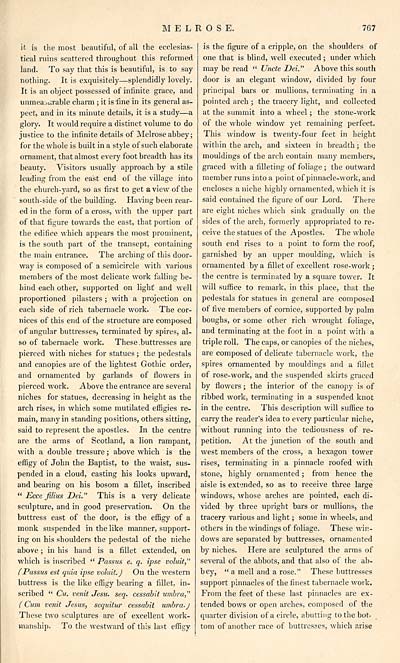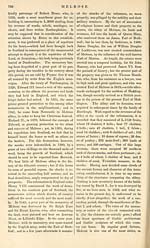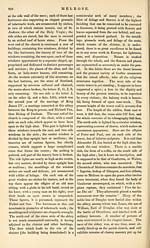Gazetteer of Scotland > Volume 2
(283) Page 767
Download files
Complete book:
Individual page:
Thumbnail gallery: Grid view | List view

MELROSE.
7G7
it is the most beautiful, of all the ecclesias-
tical ruins scattered throughout this reformed
land. To say that this is beautiful, is to say
nothing. It is exquisitely — splendidly lovely.
It is an object possessed of infinite grace, and
unmeaoiirable charm ; it is fine in its general as-
pect, and in its minute details, it is a study — a
glory. It would require a distinct volume to do
justice to the infinite details of Melrose abbey;
for the whole is built in a style of such elaborate
ornament, that almost every foot breadth has its
beauty. Visitors usually approach by a stile
leading from the east end of the village into
the church- yard, so as first to get a view of the
south-side of the building. Having been rear-
ed in the form of a cross, with the upper part
of that figure towards the east, that portion of
the edifice which appears the most prominent,
is the south part of the transept, containing
the main entrance. The arching of this door-
way is composed of a semicircle with various
members of the most delicate work falling be-
hind each other, supported on light and well
proportioned pilasters ; with a projection on
each side of rich tabernacle work. The cor-
nices of this end of the structure are composed
of angular buttresses, terminated by spires, al-
so of tabernacle work. These .buttresses are
pierced with niches for statues ; the pedestals
and canopies are of the lightest Gothic order,
and ornamented by garlands of flowers in
pierced work. Above the entrance are several
niches for statues, decreasing in height as the
arch rises, in which some mutilated effigies re-
main, many in standing positions, others sitting,
said to represent the apostles. In the centre
are the arms of Scotland, a lion rampant,
with a double tressure ; above which is the
effigy of John the Baptist, to the waist, sus-
pended in a cloud, casting his looks upward,
and bearing on his bosom a fillet, inscribed
" Ecce films Dei." This is a very delicate
sculpture, and in good preservation. On the
buttress east of the door, is the effigy of a
monk suspended in the like manner, support-
ing on his shoulders the pedestal of the niche
above ; in his hand is a fillet extended, on
which is inscribed " Passus e. q. ipse voluit,"
fPassus est quia ipse voluit. J On the western
buttress is the like effigy bearing a fillet, in-
scribed " Cu. venit Jesu. seq. cessabit umbra,'"
(Cum venit Jesus, sequitur cessabit umbra. J
These two sculptures are of excellent work-
manship. To the westward of this last effigy
is the figure of a cripple, on the shoulders of
one that is blind, well executed ; under which
may be read " Uncte Dei." Above this south
door is an elegant window, divided by four
principal bars or mullions, terminating in a
pointed arch ; the tracery light, and collected
at the summit into a wheel ; the stone-work
of the whole window yet remaining perfect.
This window is twenty-four feet in height
within the arch, and sixteen in breadth ; the
mouldings of the arch contain many members,
graced with a filleting of foliage ; the outward
member runs into a point of pinnacle-work, and
encloses a niche highly ornamented, which it is
said contained the figure of our Lord. There
are eight niches which sink gradually on the
sides of the arch, formerly appropriated to re-
ceive the statues of the Apostles. The whole
south end rises to a point to form the roof,
garnished by an upper moulding, which is
ornamented by a fillet of excellent rose-work ;
the centre is terminated by a square tower. It
will suffice to remark, in this place, that the
pedestals for statues in general are composed
of five members of cornice, supported by palm
boughs, or some other rich wrought foliage,
and terminating at the foot in a point with a
triple roll. The caps, or canopies of the niches,
are composed of delicate tabernacle work, the
spires ornamented by mouldings and a fillet
of rose-work, and the suspended skirts graced
by flowers ; the interior of the canopy is of
ribbed work, terminating in a suspended knot
in the centre. This description will suffice to
carry the reader's idea to every particular niche,
without running into the tediousness of re-
petition. At the junction of the south and
west members of the cross, a hexagon tower
rises, terminating in a pinnacle roofed with
stone, highly ornamented ; from hence the
aisle is extended, so as to receive three large
windows, whose arches are pointed, each di-
vided by three upright bars or mullions, the
tracery various and light ; some in wheels, and
others in the windings of foliage. These win-
dows are separated by buttresses, ornamented
by niches. Here are sculptured the arms of
several of the abbots, and that also of the ab-
bey, " a mell and a rose." These buttresses
support pinnacles of the finest tabernacle work.
From the feet of these last pinnacles are ex-
tended bows or open arches, composed of the
quarter division of a circle, abutting to the bot-
tom of another race of buttresses, which arise
7G7
it is the most beautiful, of all the ecclesias-
tical ruins scattered throughout this reformed
land. To say that this is beautiful, is to say
nothing. It is exquisitely — splendidly lovely.
It is an object possessed of infinite grace, and
unmeaoiirable charm ; it is fine in its general as-
pect, and in its minute details, it is a study — a
glory. It would require a distinct volume to do
justice to the infinite details of Melrose abbey;
for the whole is built in a style of such elaborate
ornament, that almost every foot breadth has its
beauty. Visitors usually approach by a stile
leading from the east end of the village into
the church- yard, so as first to get a view of the
south-side of the building. Having been rear-
ed in the form of a cross, with the upper part
of that figure towards the east, that portion of
the edifice which appears the most prominent,
is the south part of the transept, containing
the main entrance. The arching of this door-
way is composed of a semicircle with various
members of the most delicate work falling be-
hind each other, supported on light and well
proportioned pilasters ; with a projection on
each side of rich tabernacle work. The cor-
nices of this end of the structure are composed
of angular buttresses, terminated by spires, al-
so of tabernacle work. These .buttresses are
pierced with niches for statues ; the pedestals
and canopies are of the lightest Gothic order,
and ornamented by garlands of flowers in
pierced work. Above the entrance are several
niches for statues, decreasing in height as the
arch rises, in which some mutilated effigies re-
main, many in standing positions, others sitting,
said to represent the apostles. In the centre
are the arms of Scotland, a lion rampant,
with a double tressure ; above which is the
effigy of John the Baptist, to the waist, sus-
pended in a cloud, casting his looks upward,
and bearing on his bosom a fillet, inscribed
" Ecce films Dei." This is a very delicate
sculpture, and in good preservation. On the
buttress east of the door, is the effigy of a
monk suspended in the like manner, support-
ing on his shoulders the pedestal of the niche
above ; in his hand is a fillet extended, on
which is inscribed " Passus e. q. ipse voluit,"
fPassus est quia ipse voluit. J On the western
buttress is the like effigy bearing a fillet, in-
scribed " Cu. venit Jesu. seq. cessabit umbra,'"
(Cum venit Jesus, sequitur cessabit umbra. J
These two sculptures are of excellent work-
manship. To the westward of this last effigy
is the figure of a cripple, on the shoulders of
one that is blind, well executed ; under which
may be read " Uncte Dei." Above this south
door is an elegant window, divided by four
principal bars or mullions, terminating in a
pointed arch ; the tracery light, and collected
at the summit into a wheel ; the stone-work
of the whole window yet remaining perfect.
This window is twenty-four feet in height
within the arch, and sixteen in breadth ; the
mouldings of the arch contain many members,
graced with a filleting of foliage ; the outward
member runs into a point of pinnacle-work, and
encloses a niche highly ornamented, which it is
said contained the figure of our Lord. There
are eight niches which sink gradually on the
sides of the arch, formerly appropriated to re-
ceive the statues of the Apostles. The whole
south end rises to a point to form the roof,
garnished by an upper moulding, which is
ornamented by a fillet of excellent rose-work ;
the centre is terminated by a square tower. It
will suffice to remark, in this place, that the
pedestals for statues in general are composed
of five members of cornice, supported by palm
boughs, or some other rich wrought foliage,
and terminating at the foot in a point with a
triple roll. The caps, or canopies of the niches,
are composed of delicate tabernacle work, the
spires ornamented by mouldings and a fillet
of rose-work, and the suspended skirts graced
by flowers ; the interior of the canopy is of
ribbed work, terminating in a suspended knot
in the centre. This description will suffice to
carry the reader's idea to every particular niche,
without running into the tediousness of re-
petition. At the junction of the south and
west members of the cross, a hexagon tower
rises, terminating in a pinnacle roofed with
stone, highly ornamented ; from hence the
aisle is extended, so as to receive three large
windows, whose arches are pointed, each di-
vided by three upright bars or mullions, the
tracery various and light ; some in wheels, and
others in the windings of foliage. These win-
dows are separated by buttresses, ornamented
by niches. Here are sculptured the arms of
several of the abbots, and that also of the ab-
bey, " a mell and a rose." These buttresses
support pinnacles of the finest tabernacle work.
From the feet of these last pinnacles are ex-
tended bows or open arches, composed of the
quarter division of a circle, abutting to the bot-
tom of another race of buttresses, which arise
Set display mode to: Large image | Transcription
Images and transcriptions on this page, including medium image downloads, may be used under the Creative Commons Attribution 4.0 International Licence unless otherwise stated. ![]()
| Gazetteers of Scotland, 1803-1901 > Gazetteer of Scotland > Volume 2 > (283) Page 767 |
|---|
| Permanent URL | https://digital.nls.uk/97434218 |
|---|
| Description | Volume II: Glenbanchor to Zetland. |
|---|---|
| Attribution and copyright: |
|
| Description | By Robert Chambers and William Chambers. Glasgow: Blackie & Son, 1838. 2 volumes. |
|---|---|
| Shelfmark | NF.1461.g.7 |
| Additional NLS resources: | |

